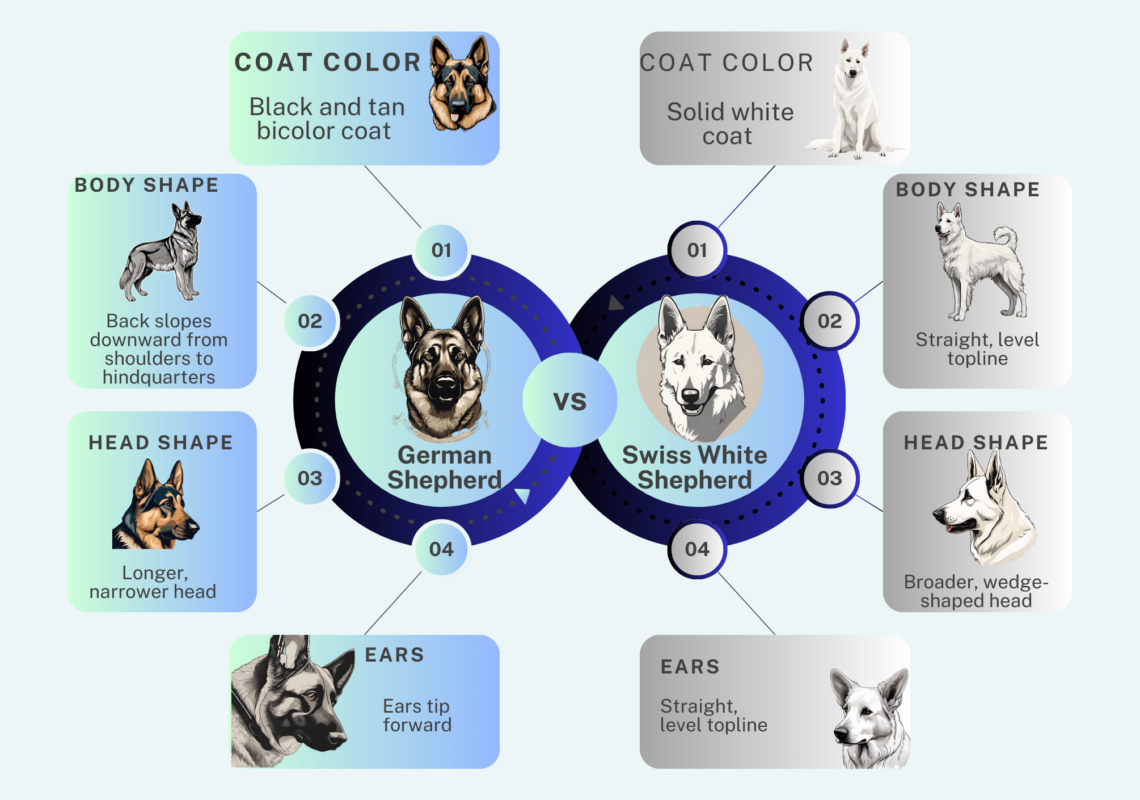German Shepherds and Swiss White Shepherds are two popular breeds that share a recent common ancestry but have diverged into distinct breeds with key differences. This blog post will compare and contrast the history, appearance, temperament, and health of German and Swiss White Shepherds to help you better understand these remarkable dogs.
Understanding the nuanced differences as well as similarities between these two breeds can help prospective owners choose the right shepherd dog for their lifestyle. Read on to learn more!

History of German Shepherds and Swiss White Shepherds
Origins
The German Shepherd breed originated in Germany in 1899. Cavalry officer Max von Stephanitz is credited with formalizing the breed we recognize today using various local herding dogs in Germany. The breed was immediately popular for its intelligence, trainability, and utility as an all-around working dog.
Emergence of White Coated Dogs
White coated German Shepherd dogs emerged early in the breed’s development. However, the all-white coat was considered a fault by breed registries and most breeders culled these white puppies from litters. Still, the white coat persisted as a recessive trait.
Creation of the Swiss White Shepherd
In the 1960s, enthusiasts in Switzerland began selectively breeding white German Shepherds to stabilize the white coat. By breeding the dogs with no consideration for color, the Swiss White Shepherd eventually became recognized as a separate breed in 2011.
Appearance: Similarities and Differences

Size
Both breeds are classified as medium to large dogs. Males and females typically range between 22-26 inches tall at the shoulder and weigh 50-90 pounds.
Build
The German and Swiss White Shepherd share a similar athletic, muscular build. They have a domed forehead, alert triangular ears, strong jaws, and a bushy tail. Their double-layered coat helps protect them from weather and shed dirt.
Coat and Color
Here is where these breeds differ significantly. The German Shepherd comes in various colors including black and tan, sable, black, white and more. Swiss White Shepherds have a solid white coat. White shepherds cannot compete in breed shows for German Shepherds because of this distinguishing color.
Facial Markings
Both breeds may have tan or black facial markings including a mask over the eyes and muzzle. White shepherds have a lighter masking. The overall impression is a more subdued facial expression compared to the German Shepherd.
Temperament: Bold, Loyal, Intelligent
Confident and Courageous
Both German and Swiss White Shepherds are known for their confidence. They have a noble, self-assured attitude and fearless nature. Their breeding as working dogs means they are bold and steady when facing perceived threats.
Loyal and Devoted
These shepherds form a strong bond with their handler or family. Their loyalty is unmatched. They aim to please their owners and enjoy being given a job or task.
Playful and Gentle
Despite their size, shepherds are gentle giants when raised properly. They retain a playful puppy spirit into adulthood. The breeds do well with children and love to play when given proper supervision and interaction.
Intelligent and Trainable
German Shepherds and Swiss White Shepherds are prized for their intelligence. Owners need to provide regular mental stimulation and exercise. If bored, these dogs can become destructive.
Wary of Strangers
Natural protectiveness makes Shepherds excellent watchdogs. They are initially shy around strangers and attuned to potential threats. However, aggression is strongly discouraged in these breeds. With proper socialization as puppies, they can learn to be comfortable with visitors.
Health and Care
Exercise Needs
Both breeds have high exercise needs. Shepherds thrive when given at least an hour of rigorous daily exercise along with mental stimulation through training or dog sports. They enjoy having a job or task and excel at canine roles from search and rescue to disability assistance.
Grooming and Shedding
The double coat sheds moderately year-round. More frequent brushing is required during seasonal shedding periods. Occasional bathing and nail trimming will help keep your shepherd’s coat healthy and skin free of irritation.
Training Requirements
These highly intelligent breeds need early socialization and obedience training starting in puppyhood. Shepherds excel at agility, obedience competitions, scent work and more with proper training.
Major Health Concerns
Here are major health concerns that are found in German shepherds and Swiss Shepherd
- Hip and elbow dysplasia – malformation of joints
- Degenerative myelopathy – degeneration of the spinal cord
- Bloat – life-threatening stomach condition
- Allergies – environmental or food-related
Lifespan
With proper care, shepherds typically live 9-13 years. Swiss White Shepherds can live a bit longer, reaching up to 15 years.
Source:


